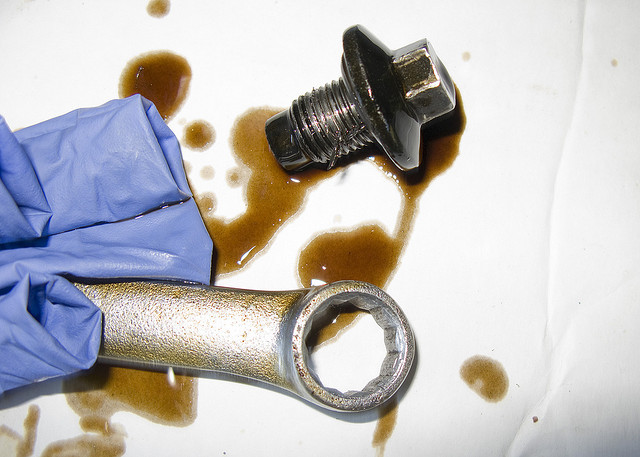With the economy slowing, everyone is looking to cut back in many ways. Some people are eliminating their daily coffee, others are combining trips to save on gas. These and similar strategies are great and will help you save money. However, there is more money to be saved by learning how to do some simple things for yourself.
None of the tasks below are particularly challenging or taxing for the average, intelligent, physically capable person, yet many of us pay others to do them. Why? Convenience, for one. Not wanting to/not having the time to learn, for another. Then there’s the intimidation factor. Some people believe that learning something new is going to be too hard.
But when you’re looking to make big budget cutbacks (or if you just like to save money even if you don’t “have to”) nothing beats DIY. So here are thirteen easy things you can learn to do yourself that have a big impact on your budget.
1. Change your own oil and other routine car maintenance.
If you drive an average of 12,000 miles a year, you’re probably having your oil changed four times per year, more often if you drive more than that. Most professional oil changes range from $45-120. However, you can do it yourself for less than thirty dollars and it will only take about fifteen minutes once you get good at it. You can also learn to change your own flat tires, top off your fluid levels, repair minor problems, and properly inflate your tires, all of which save you the time and money wasted at the garage.
2. Cut your own hair.
Or at least that of others in your household. Haircuts at the chain salons start at around $24, plus tip. At designer salons the price is much higher. That’s kind of steep if you or someone in your house has low maintenance hair that just needs a trim or a buzz . You can get a set of clippers and scissors for as low as $40 at places like Wal-Mart or Target that allow you to do a perfectly serviceable job. Your investment in the clippers will pay for itself in the first couple of uses, making every subsequent cut free.
3. Do your own yard work.
The quotes I’ve seen for mowing begin around $150/month, with grass being mowed once per week (weed eating is usually extra). That’s $37.50 per mow. You can buy a decent push lawn mower for $125. Even factoring in gas, you’ll still come out ahead after just a few mows. Companies like ChemLawn and TruGreen charge around $80-100/month for fertilizer service. You can buy a spreader or hose attachment and the fertilizer at Lowes for around $40 total and spread it yourself. Trim your own hedges and whack your own weeds and save even more. Doing your own lawn work is also great exercise, which might enable you to drop the gym membership and save some more money.
4. Power wash your own house and clean your own gutters.
Professional power washers charge around $100 and up for a simple house; more if they have to climb very high or do a lot of square footage. You can rent a power washer for as low as $47/day with a refundable deposit when you return it. Most medium sized houses only take a day or less to do. Similarly, professional gutter cleaning on average costs about $162. Do it yourself for free.
5. Groom your own pet.
Professional pet grooming starts around $30 and $70 for a simple bath, depending on the size of your dog. Add more if you need nails clipped, teeth brushed, or hair clipped. Pet grooming is easy to do yourself and the materials are all available at places like PetSmart, Petco, Target, or Wal-Mart. A large bottle of shampoo can cost as little as $9, cologne is around $7, and a toothbrush and toothpaste set goes for around $12. Nail clippers (as low as $6) or a Dremel tool (as low as $35 for some models) are cost effective ways to do nails. Hair clipping sets are also inexpensive when compared to the cost of paying someone to do it over and over again. And if you mess up the first time, it’s not like the other dogs will be making fun of Fido’s bad haircut. Just let it grow out and try again.
6. Learn basic computer maintenance and problem solving.
We turn on our computers and expect them to work. But when they don’t, if we don’t know what to do, it results in a costly call to tech support or a repair person. To have someone come out and install a new operating system or update the old one will cost between $19.99 to $1,450, if you call Geek Squad, for example. Recovery of lost data starts at $84 plus parts and other costs (here). With prices like these, a little knowledge can save you a ton of money. Computers are not difficult to figure out and there are many free forums on the Internet that can provide help and a free education.
7. Learn some basic home maintenance/repair.
There are lots of projects around the home that can be done on your own, but many people call for professional help. Learn how to snake a drain or plunge a toilet to remove clogs. Installing a new faucet or fixing a leaky one is easy to do. Replacing existing lighting is also easy. Replacing bent or broken roof shingles is usually an easy task. Installing garage door openers, replacing damaged siding, installing insulation, and cleaning ductwork are all pretty painless. There are many things that you may currently pay others to do around your home that are very easy to learn. Pick a few to tackle and do them yourself.
8. Learn basic appliance troubleshooting and maintenance.
Maybe the only reason your vacuum cleaner isn’t working is because it needs a new belt. Or your dryer isn’t drying because the exhaust pipe is clogged with lint. Or your dishwasher isn’t draining because there’s a piece of food blocking the drain. Maybe something just blew a fuse. Sometimes an appliance problem is a very small thing that you can either fix on the spot or fix with a small, inexpensive part replacement. However, unless you can figure out what the problem is, you’re going to have to shell out for an expensive service call. Or, worse, you’re going to assume the appliance is toast and go out and buy another. So learn a little about your appliances and how they work so you can fix minor problems yourself.
9. Learn how to paint and/or wallpaper a room.
Even if you don’t want to change your color scheme, sooner or later you’re going to have to repaint your rooms. Paying a contractor to do this begins at $2,000 and $14,000 for a small house (1,200 sq. ft. or so), with costs rising with the size/height of the rooms, quality of the paint you choose, and the overall complexity of the job. However, you can buy enough supplies to paint that same entire house for as little as $400-800, depending on the quality of paint and brushes you choose. You can buy enough supplies to paint individual rooms for far less. Correct painting/papering techniques are easy to learn. Beyond that, all you need is some muscle for moving furniture.
10. Learn basic building techniques.
Learn how to hammer a nail and how to choose wood wisely and you open up a whole new world. You can repair/replace your own steps and decks, build your own doghouse or shed, build a fence, or construct a playhouse for the kids. There are many low-complexity building projects that can be tackled by someone who only has a rudimentary knowledge of building. Get very good at it, and you can build your own addition onto your house.
11. Do your own alterations.
Hemming pants and skirts is not that difficult and neither is taking in or letting out a garment. Basic alterations usually start at $20 or so and go up depending on the fabric and complexity of the alteration. But you can find a good quality sewing machine for $100 or a under on sale. Use it five times and it’s paid for itself. As a bonus, you can sew other money saving items with it like simple clothes for kids, slipcovers for old chairs, pillows, stuffed toys, etc.
12. Clean your own house.
This one sounds simple, but many people don’t really know how to clean a house. Routine cleaning is very easy to learn and harder things like cleaning blinds, drapes, carpet, and upholstery are also easily mastered. A professional housekeeping service might charge upwards of $100/hour. You can buy all the supplies you need for far less than that or make some eco-friendly alternatives for almost nothing.
13. Learn how to protect your own identity.
New services such as Lifelock are springing up claiming to help you protect your identity. These charge around $140 per year, per adult. However, you can do all of the same things for free by getting your own credit report free from www.annualcreditreport.com, understanding how to dispute erroneous information, knowing how to freeze your credit, understanding how to place a fraud alert, removing your name from pre-approved credit card mailings and other junk mail, and monitoring your accounts and statements.
DIY Has A Ton Of Benefits
DIY has many benefits including complete control of the project, avoidance of contractors’ high hourly rates which cause costs to skyrocket, and the thrill of learning and mastering something new. There’s nothing like being able to point to something and say, “I did that.” Plus, if you get good enough at something, you may find that others are willing to pay for your skills, further increasing your income.
There are lots of free or low cost resources that can teach you what you need to know in order to master these DIY skills. Books are available through libraries or book sales, free websites abound with tips and tricks, and free classes are regularly held at stores like Home Depot and Lowes. Even a course through the local community college will save you money in the long run once you put your new skills to use. You may also have the benefit of a handy parent, sibling, or friend who can teach you what you need to know. If you need special equipment, much of what’s needed can be rented. Even if you purchase, you’re likely to earn your money back in a very short time. So get out there, learn something new, and start saving money.
Image courtesy of Tanya Ryno
Read the full article here











